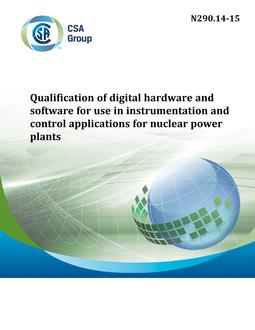CSA N290.14-15
Preface
This is the second edition of CSA N290.14, Qualification of digital hardware and software for use in instrumentation and control applications for nuclear power plants. It supersedes the previous edition published in 2007 under the title Qualification of pre-developed software for use in safety-related instrumentation and control applications in nuclear power plants. This Standard has been expanded to cover a wider range of software qualification applications, and also covers hardware qualification of digital systems. This Standard establishes a qualification process for digital instrumentation and control systems and components for use in nuclear power plants and provides guidance for maintaining qualification once it has been established. This Standard addresses application-specific qualification. It outlines a set of qualification concerns and failure modes that allow candidate products to be assessed within the context of their applications. It is intended for this Standard to be used by the licensees of nuclear power plants, as well as the designers, manufacturers, and fabricators of nuclear power plant systems and components. This Standard adopts a selection process for safety categories as provided in other national and international standards and industry guides. Further guidance on equipment qualification is provided by other CSA and IEC standards. This Standard is one of a series of standards on reactor control systems, safety systems, and instrumentation for nuclear power plants. The CSA N-Series of Standards provides an interlinked set of requirements for the management of nuclear facilities and activities. CSA N286 provides overall direction to management to develop and implement sound management practices and controls, while the other CSA nuclear Standards provide technical requirements and guidance that support the management system. This Standard works in harmony with CSA N286 and does not duplicate the generic requirements of CSA N286; however, it may provide more specific direction for those requirements. Users of this Standard are reminded that the design, manufacture, construction, commissioning, operation, and decommissioning of nuclear facilities in Canada are subject to the provisions of the Nuclear Safety and Control Act and its supporting Regulations.
Scope
1.1 This Standard defines requirements for the process of qualification of digital hardware and software for use in instrumentation and control applications for NPPs. Notes: 1) This Standard applies to individual safety-related programmable digital devices containing software or programmable logic (e.g., devices such as application-specific integrated circuit (ASICs), complex programmable logic device (CPLD), and field-programmable gate array (FPGAs)). 2) This Standard may provide guidance for nuclear facilities other than NPPs, using a graded approach. 1.2 This Standard refers directly to other industry standards for topics related to the categorization of functions, hardware qualification aspects, and software qualification aspects. 1.3 This Standard does not apply to business systems (e.g., business applications, desktop computers, email, business networks), analysis software (e.g., scientific, engineering, and safety analysis software), or passive devices (e.g., wires), unless they are part of a safety-related computing system. Note: For requirements related to analysis software refer to CSA N286.7. 1.4 Annex E, provides guidance that focuses on activities unique to the integration of a digital item, based on recent best practice and operating experience. Note: Refer to CSA N290.12 for integration concerns with respect to human factors. 1.5 This Standard assumes that the candidate product has been previously assessed as functionally suitable for the proposed application. Note: Functional suitability is a determination of the degree to which a product can meet the specified requirements including confirmation that the use of the digital item does not conflict with the requirements of the application. This Standard is used to qualify the product after this determination is made. 1.6 In this Standard, “shall” is used to express a requirement, i.e., a provision that the user is obliged to satisfy in order to comply with the standard; “should” is used to express a recommendation or that which is advised but not required; and “may” is used to express an option or that which is permissible within the limits of the Standard. Notes accompanying clauses do not include requirements or alternative requirements; the purpose of a note accompanying a clause is to separate from the text explanatory or informative material. Notes to tables and figures are considered part of the table or figure and may be written as requirements. Annexes are designated normative (mandatory) or informative (non-mandatory) to define their application.
Product Details
- Edition:
- 2nd
- Published:
- 11/01/2015
- ISBN(s):
- 9781771399326
- Number of Pages:
- 49
- File Size:
- 1 file , 1.7 MB
- Product Code(s):
- 2424103, 2424372, 2424103, 2424103
